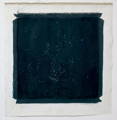Early autumn after the summer harvest, Twee Jonge Gezellen is particularly quiet. Nature’s silent alchemy left in stillness to begin its ancient work. After a year of pause and apprehension, my work is informed by a dreamlike state of deceleration, of stillness and slumber.
Art is born in the mental space of freedom and this particular rural setting offered me the physical space to roam at will so very far from the city, especially at night.
Elements of the nocturnal farm seep into my work, sometimes literally, sometimes symbolically.
The ravine, the dam, the vineyards.
Dimly-lit Spider Lilies and fragrant hallucinogenic Brugmansias.
Even my palette would adapt to more midnight blues, Payne’s grey, cerulean blue, deep ochre.
Often during my time on the farm, I am reminded of my favourite Emily Dickinson poem: We Grow Accustomed to the Dark, which is a celebration of human ability to adjust to uncertainty.
It is a true gift to be able to pause in silence and disconnect from routine to find a deeper connection between art, nature and self.
- Sanell Aggenbach










